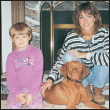Physical Characteristics of the Vizsla
(from the American Kennel Club breed standard)
Head: Lean and muscular. Skull moderately wide between the ears with a median line down the forehead. Stop between skull and foreface is moderate, not deep.
Ears: Thin, silky and proportionately long, with rounded-leather ends, set fairly low and hanging close to cheeks.
Eyes: Medium in size and depth of setting, their surrounding tissue covering the whites. Color of the iris should blend with the color of the coat.

Nose: Brown. Nostrils slightly open.
Neck: Strong, smooth and muscular, moderately long, arched and devoid of dewlap, broadening nicely into shoulders which are moderately laid back.
Muzzle: Square and deep. Foreface is of equal length or slightly shorter than skull when viewed in profile, should taper gradually from stop to tip of nose.
Jaws: Strong with well developed white teeth meeting in a scissors bite. Lips cover the jaws completely but are neither loose nor pendulous.
Chest: Moderately broad and deep reaching down to the elbows. Ribs well-sprung; underline exhibiting a slight tuck-up beneath the loin.
Forequarters: Shoulder blades proportionately long and wide sloping moderately back and fairly close at the top. Forelegs straight and muscular with elbows close. Feet cat-like, round and compact with toes close.
Coat: Short, smooth, dense and close-lying, without woolly undercoat.
Body: Strong and well proportioned. Back short. Withers high and the topline slightly rounded over the loin to the set on of the tail.
Tail: Set just below the level of the croup, thicker at the root and docked one-third off. Ideally, it should reach to the back of the stifle joint and be carried at or near the horizontal.
Hindquarters: Hind legs have well developed thighs with moderately angulated stifles and hocks in balance with the moderately laid back shoulders. The hocks are let down and parallel to each other.
Size: The ideal male is 22 to 24 inches at the highest point over the shoulder blades. The ideal female is 21 to 23 inches.
Color: Solid golden rust in different shadings. Solid dark mahogany red and pale yellow are faulty. White on the forechest, preferably as small as possible, and white on the toes are permissible.
Feet: Rounded with toes short, arched and tight. Cat-like foot is required; hare foot undesirable. Nails short, strong and a shade darker in color than coat; dewclaws should be removed.

Contents

Meet the Hungarian Vizsla, an ancient hunting dog of the Magyar tribes with a rich history and an aristocratic nobility. Follow the Vizslas fleet-footed path as a hunter of deer, wild boar and hare in Europe to its role as companion, show dog and field trial expert in Britain, the US and around the world.

Take note of some golden pointers about the Golden Pointer of Hungary, the Vizsla. Learn about the breeds affectionate manner and his superior multi-tasked hunting abilities. Find out if your household and family are well suited to the high-energy, people-adoring Vizsla.

Learn the requirements of a well-bred Vizsla by studying the description of the breed set forth in the American Kennel Club standard. Both show dogs and pets must possess key characteristics as outlined in the breed standard.

Find out about how to locate a well-bred Vizsla puppy. Discover which questions to ask the breeder and what to expect when visiting the litter. Prepare for your puppy shopping spree. Also discussed are home safety, the first trip to the vet, socialization and solving basic puppy problems.

Cover the specifics of taking care of your Vizsla every day: feeding for the puppy, adult and senior dog; grooming, including coat care, ears, eyes, nails and bathing; and exercise needs for your dog. Also discussed are the essentials of dog identification.

Begin with the basics of training the puppy and adult dog. Learn the principles of house-training the Vizsla, including the use of crates and basic scent instincts. Enter Puppy Kindergarten and introduce the pup to his collar and leash and progress to the basic commands. Find out about obedience classes and other activities.

By Lowell Ackerman DVM, DACVD
Become your dogs healthcare advocate and a well-educated canine keeper. Select a skilled and able veterinarian. Discuss pet insurance, vaccinations and infectious diseases, the neuter/spay decision and a sensible, effective plan for parasite control, including fleas, ticks and worms.

Know when to consider your Vizsla a senior and what special needs he will have. Learn to recognize the signs of aging in terms of physical and behavioral traits and what your vet can do to optimize your dogs golden years. Consider some advice about saying goodbye to your beloved pet.

Step into the center ring and find out about the world of showing pure-bred dogs. Heres how to get started in AKC shows, how they are organized and whats required for your dog to become a champion. Take a leap into the realms of obedience trials, agility and hunting tests.
KENNEL CLUB BOOKS VIZSLA
ISBN 13: 978-1-59378-270-2
eISBN 13: 978-1-59378-960-2
Copyright 2004 Kennel Club Books A Division of BowTie, Inc.
40 Broad Street, Freehold, NJ 07728 USA
Cover Design Patented: US 6,435,559 B2 Printed in South Korea
All rights reserved. No part of this book may be reproduced in any form, by photostat, scanner, microfilm, xerography or any other means, or incorporated into any information retrieval system, electronic or mechanical, without the written permission of the copyright owner.
10 9 8 7 6 5 4 3 2 1
Photography by Isabelle Franais
with additional photographs by
Paulette Braun, T.J. Calhoun, Alan and Sandy Carey, Carol Ann Johnson, Bill Jonas and Tam C. Nguyen.
Illustrations by
Renee Low
and Patricia Peters.
Next page


















